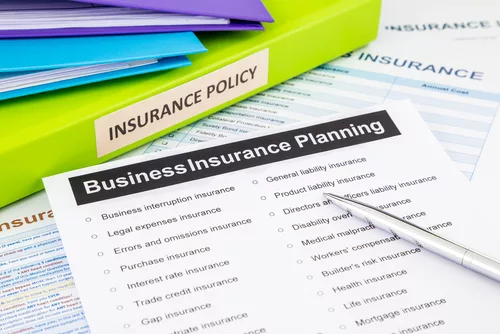 Business insurance planning checklist with documents and binders" width="500" height="334" />
Business insurance planning checklist with documents and binders" width="500" height="334" /> Business insurance planning checklist with documents and binders" width="500" height="334" />
Business insurance planning checklist with documents and binders" width="500" height="334" />
Nobody can predict the future. Whether it be a fire, flooding, theft, or any other unfortunate mishap, there is always a possibility of unexpected loss in your business assets .
That is where business insurance comes in. And while business insurance is totally necessary, it cannot work well for you if you do not give the insurer an accurate statement of values. What is a statement of values?
In this article, we will explore what a statement of values is and how to prepare one for your insurance policy.

So, what is a statement of values? A statement of values or SOV is a report the insured submits to an insurer that helps determine the insurance premium. The SOV tells just how much a property is worth so the underwriter knows how the premium should be calculated.
Since various types of property (tenant improvements, inventory, equipment, etc) can be listed on the document, the underwriter will have different ratings based on the various categories. The SOV should include information on:
If you are insuring more than one property, you will need to do one SOV for each location. It is important that the information you give is accurate and fully details the value of your property. If you don’t fully disclose everything of value, you will be underinsured.
Determining the insurance premium is not the only use for the SOV. Other uses for the statement of values include:
There are many ways to calculate a property’s value. But which is right for you and your property? It depends on the property insured and your needs. In some cases, it may be a good idea to choose an alternative valuation method to insure your property at a lower premium.
Here are some of the most common valuation methods.
Once you are ready to insure your property, you will need to prepare your SOV. Mistakes on your SOV list of values could mean being underinsured, leaving your property vulnerable to risk. Your insurer will likely have some spreadsheets and forms to help guide the process.
To ensure the information is accurate and fully comprehensive, get some help from a financial professional. Work with your broker, underwriter, appraisal partner, or insurance provider to not only review your information but to figure out strategies to get the best coverage possible at a rate that works for you.
Here are a couple of other tools to help you to prepare your statement of values:
The document itself is typically an Excel spreadsheet with a long list or even a web-based software program. Once you’ve completed the SOV, check over it for the following:
It is not possible to disclose too much data about the property. Having any gaps in data on the SOV will be a bad sign to the underwriter. Therefore, be sure to look over the information to make sure you didn’t miss anything.
Check and double-check the data. Ensure that all the information is correct and up-to-date. Be precise in what you disclose instead of using rounded-up amounts, vague descriptions, or wrong addresses. Additionally, if there is more than one building on the property, create entries for each building.
Lumping all the buildings into one property can cause confusion and issues with your policy. For instance, if the property is a school, be sure to complete an entry for each building. For example, the gym, each building of classrooms, and the football arena will each have its entry. You will want each structure covered in case there is a loss.
To check for inaccuracies, here are a few questions to ask yourself:
Not knowing the answers to these questions could put you at risk of submitting inaccurate information, and could put your property at risk in case of a disaster.
The information you provide should not only be accurate, but it should also be consistent. Sometimes when many people are working within one spreadsheet, it can cause some inconsistencies in the information. That is why it could be helpful to utilize a web-based software tool.
These tools can be accessed by all employees, including a history of the audits done, and the approvals given. Using an organized system can help with any inconsistencies that can occur in property schedules. Once your SOV report is done and has been reviewed a few times, the total number you’ve come up with is referred to as Total Insurable Value (TIV).
 underwriter insurance premium working in office" width="1505" height="1003" />
underwriter insurance premium working in office" width="1505" height="1003" />
Next, it is then time to submit it to your underwriter. He or she will come up with a premium based on the information. After you’ve signed the documents agreeing to the stated premium, your policy will be activated. Over time, you will want to come back and review your SOV to make sure you aren’t underinsured in case things have changed.
Constantly reassess the values of your assets. If these values change, this means your property is no longer covered with an adequate premium. Therefore, it might be a good idea to get an insurance replacement appraisal from a certified third party to submit to your insurer.
There are also government agencies and risk pools that partner with third-party appraisers to do on-site inspections to verify their data. This can be an extra resource when you want to obtain accurate, up-to-date information about your property. If you’ve found a blind spot in your coverage, the update to your SOV can change your premium. However, your property will no doubt be covered in the event of a claim since there are no longer gaps in coverage.
If it all goes according to plan, you should be accurately insured. However, there are several risks when it comes to insurance premiums:
Typically those clients that choose the coinsurance clause will have a coinsurance limit of 90%, which is the most common limit. This means that they must insure at least 90% of their property value’s replacement cost. Let’s look at an example.
If a client goes with an insurable limit of $750,000 on a $1,000,000 property, they are choosing to insure less than the coinsurance clause limit (90%). The policy they choose has a deductible of $1,000. The building was damaged in a hurricane, totaling $250,000 in damages.
And since the client did not meet the minimum of 90% insurable limit, they will be faced with the coinsurance penalty. To find out how much the penalty is, you must apply the following equation:
Amount insured/the amount should have insured X the amount of loss = amount insurance policy will pay
In this example, the equation will go as follows:
$750,000 (insured) / $900,000 (should have insured) X $250,000 (loss) = $208,333 will be paid by insurance company
If the client had insured $900,000 or more, he or she would only have had to pay the $1,000 deductible. However, in this scenario, the client had to pay $41,667 ($250,000 – $208,333=$41,667). This scenario is a good reason why it is best to insure the minimum limit stipulated in the coinsurance clause.
Along with submitting accurate information in your SOV, you can avoid overpaying, underpaying, and instead receive the most ideal coverage you need.
We hope we answered the question, “What is a statement of values?” If you’d like more information on your property insurance policy, contact us . We’d be happy to help.
If You Like Please Share It: